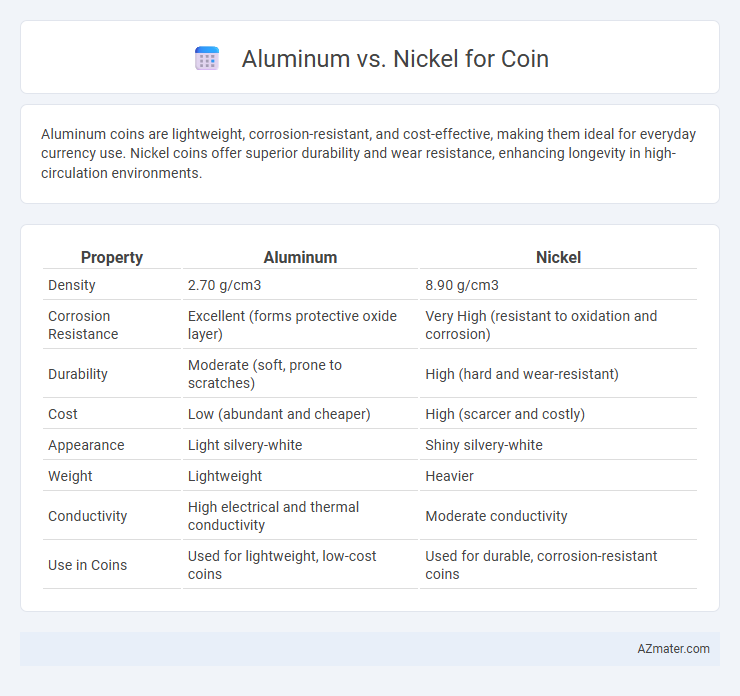Aluminum coins are lightweight, corrosion-resistant, and cost-effective, making them ideal for everyday currency use. Nickel coins offer superior durability and wear resistance, enhancing longevity in high-circulation environments.
Table of Comparison
| Property | Aluminum | Nickel |
|---|---|---|
| Density | 2.70 g/cm3 | 8.90 g/cm3 |
| Corrosion Resistance | Excellent (forms protective oxide layer) | Very High (resistant to oxidation and corrosion) |
| Durability | Moderate (soft, prone to scratches) | High (hard and wear-resistant) |
| Cost | Low (abundant and cheaper) | High (scarcer and costly) |
| Appearance | Light silvery-white | Shiny silvery-white |
| Weight | Lightweight | Heavier |
| Conductivity | High electrical and thermal conductivity | Moderate conductivity |
| Use in Coins | Used for lightweight, low-cost coins | Used for durable, corrosion-resistant coins |
Introduction to Coinage Materials
Aluminum and nickel are widely used materials in coinage due to their distinct properties and cost-effectiveness. Aluminum offers lightweight, corrosion resistance, and ease of minting, making it ideal for lower denomination coins, while nickel provides superior durability, wear resistance, and a lustrous finish favored in higher-value or commemorative coins. The selection between aluminum and nickel depends on factors such as coin circulation lifespan, manufacturing expense, and desired physical characteristics.
Overview of Aluminum and Nickel in Minting
Aluminum is prized in minting for its lightweight properties, corrosion resistance, and cost-effectiveness, making it ideal for mass production of everyday coins. Nickel offers superior durability and a lustrous finish, enhancing coin longevity and aesthetic appeal, especially in circulation coins that require resistance to wear and tarnish. Both metals are often alloyed to balance economic viability and physical durability, with nickel-aluminum combinations optimized for various minting applications worldwide.
Historical Use of Aluminum vs Nickel for Coins
Aluminum began replacing traditional metals in coinage during the early 20th century, prized for its lightweight and corrosion resistance, with notable examples including Soviet and European coins from the 1920s onward. Nickel, historically favored since the mid-19th century, was utilized extensively for its durability and resistance to wear, exemplified by the U.S. nickel coin introduced in 1866 and Canadian five-cent pieces. The transition from nickel to aluminum in various countries often reflected shifts in metal availability and economic factors, influencing the metal composition in coin production throughout the 20th century.
Physical and Chemical Properties Comparison
Aluminum coins are lightweight with a density of 2.70 g/cm3, exhibit excellent corrosion resistance due to a protective oxide layer, and have a melting point of 660degC, making them easier to mint. Nickel coins are denser at 8.90 g/cm3, possess superior hardness and durability, and resist oxidation well with a melting point of 1455degC, contributing to longer-lasting circulation coins. Chemically, aluminum is more reactive and prone to forming protective oxide films, while nickel's lower reactivity provides enhanced wear resistance in high-contact environments.
Durability and Lifespan of Aluminum vs Nickel Coins
Nickel coins exhibit superior durability compared to aluminum coins due to nickel's higher resistance to wear, corrosion, and deformation, extending their lifespan significantly in circulation. Aluminum coins tend to be softer and more prone to scratches, dents, and surface degradation, which shortens their effective usability. The extended lifespan of nickel coins reduces replacement frequency and maintenance costs, making them more economical for long-term use in currency systems.
Cost Efficiency and Production Considerations
Aluminum coins offer significant cost efficiency due to the metal's low raw material price and lightweight properties, which reduce transportation and minting expenses. Nickel, although more durable and corrosion-resistant, incurs higher costs in material procurement and energy-intensive production processes. Production considerations also favor aluminum because its softness enables faster minting cycles and less wear on dies compared to the harder, more abrasive nickel alloys.
Counterfeit Resistance and Security Features
Nickel coins exhibit superior counterfeit resistance compared to aluminum due to their higher density and magnetic properties, which are harder to replicate with common materials. Security features such as intricate minting patterns and electromagnetic signatures are more effectively integrated into nickel coins, enhancing verification processes. Aluminum coins, while cost-effective and lightweight, lack the robust physical characteristics that deter sophisticated counterfeiting techniques.
Environmental Impact and Sustainability
Aluminum coins typically have a lower carbon footprint due to the metal's abundance and recyclability, reducing environmental impact compared to nickel. Nickel mining often involves significant ecological disruption and energy-intensive processes, leading to higher greenhouse gas emissions. The sustainability of aluminum as a coin material is enhanced by efficient recycling systems, which minimize resource depletion and waste generation.
Global Trends in Coin Material Selection
Global trends in coin material selection reveal a growing preference for aluminum due to its lightweight, corrosion resistance, and cost-effectiveness compared to nickel. Rising nickel prices and supply chain constraints have prompted mints worldwide to shift towards aluminum alloys, which also enable easier recycling and lower environmental impact. Countries such as Canada and India have adopted aluminum-based coins, reflecting a broader movement toward sustainable and economically efficient numismatic practices.
Conclusion: Which Metal is Best for Coinage?
Nickel offers superior durability and corrosion resistance compared to aluminum, making it the preferred choice for high-circulation coins. Aluminum is lightweight and cost-effective but lacks the strength required for long-term use in coinage. Considering wear resistance, nickel's robustness ensures better longevity, establishing it as the best metal for most coinage applications.

Infographic: Aluminum vs Nickel for Coin
 azmater.com
azmater.com